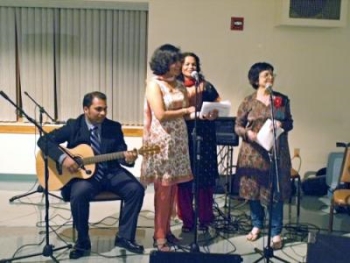Goa’s sublime musical creation
It was cool and pleasant up in the hill station of Panchgani where we were spending our summer holiday in the late 1950s. On the very first night, after dinner, my parents and the rest of our group were relaxing in the cosy living room of the cottage we had rented; my younger sister Vera, a two-year old toddler then, and I were looking out of one of the open windows. Vera was standing on a chair and I had a protective arm around her to make sure she didn’t fall off.
The Panchgani countryside was cloaked in darkness except for a few lights from homesteads twinkling in the distance. Cool breezes wafted in bringing with them the fragrances of night queen flowers and eucalyptus. I guess the nip in the air and the soothing breezes got the grown-ups in the mood for singing for they suddenly broke into song (singing in voices – primeiro and segundo), beginning with the aptly titled Konkani mando “Sontos bhogta re jivako” (I feel the joy of life). This is my earliest memory of listening to a Goan mando.
Since then, over the years, I’ve heard the Konkani mando sung in the spacious salas of relatives’ houses in Goa as well as in cramped homes and wedding reception halls in Bombay where I grew up.
We Goans somehow end up incorporating mandos into every happy occasion, no matter which part of the planet we’ve made our home.
 When my older son Kaustubh got married recently in the US, Dion -my close friend Maria’s son, my sisters, and I treated the guests, mostly Americans, to a lively session of mandos and dulpods, thus providing glimpses into our rich musical heritage and culture. But in deference to my family’s Maharashtrian linkage we also sang the popular Marathi song, “Gori, gori paan, phula sarkhi chaan, Dada mala ek vahini aan” (Fair and beautiful as a flower, Dear big brother get me a sister-in-law like that).
When my older son Kaustubh got married recently in the US, Dion -my close friend Maria’s son, my sisters, and I treated the guests, mostly Americans, to a lively session of mandos and dulpods, thus providing glimpses into our rich musical heritage and culture. But in deference to my family’s Maharashtrian linkage we also sang the popular Marathi song, “Gori, gori paan, phula sarkhi chaan, Dada mala ek vahini aan” (Fair and beautiful as a flower, Dear big brother get me a sister-in-law like that).
A fascinating blend of East and West
Uniquely Goan, the mando represents a blend of Indian and western musical traditions, combining Konkani lyrics and music with Portuguese musical elements. It originated somewhere in the 19th century and is popular among the upper caste Goan Catholics particularly in the Salcette region.
It has three components –poetry, music, and dance. Mostly the theme is love. The Indian gumott provides the rhythm while the main melody is played on a rebec or violin.
As for the dance, the celebrated octogenarian Dr. Jose Pereira – author, Sanskrit scholar, fresco painter and former Fordham University professor emeritus of theology, describes it as a graceful expression of “cortezia (courtesy), joi (joy) and amor (love)”.
In keeping with oriental customs, initially, there was no physical contact between the pairs of men and women dancers. In more recent times, though some of the steps do involve the holding of hands, the sexes still maintain a decorous distance from each other.
The dance encompasses the slower, elegant movements of the Minuet – a French open-couple dance, and the interweaving of dancers, foot-tapping and clapping that characterizes the English Contredanse (‘country dance’). Many mandos end with animated dulpods when the tempo of the music and the dance steps gets faster.
Here’s a link to one of our older mandos “Adeus korcho vellu paolo” (It’s time to say goodbye…) which, going by the slightly inaccurate pronunciations here and there (like in the case of many Bomboicars!), seems to be sung by Goans in Portugal. It also includes the mandolin as an accompaniment instrument.
And here’s a link to one of our newer, faster Goan mandos – “Ho mando Goencho khoro” (This is truly a Goan mando…) from the hit Konkani movie of the 1960s “Amchem Noxib” picturised on the heroine Rita Lobo and film extras.
Enjoy! And let’s keep the rich mando tradition alive!

Thanks for putting this up on your blog. Goans truly have music in their blood. The songs, music and graceful dances are fabulous. Beautiful Goa – been there dozens of times, and yet love to keep visiting the place.
Thanks for appreciating the music of Goa Jehangir. There’s more to follow….
Pingback: Viva Goa! – Part 1 | Veena Patwardhan